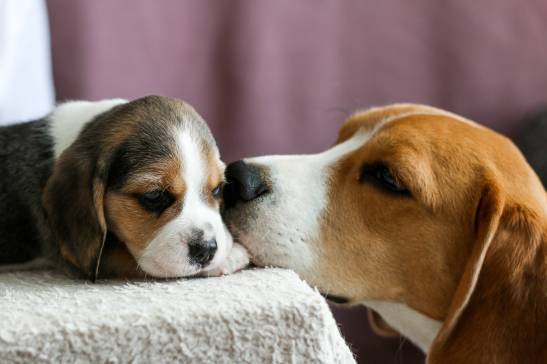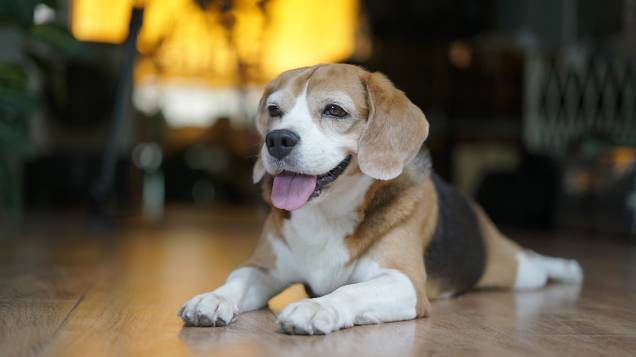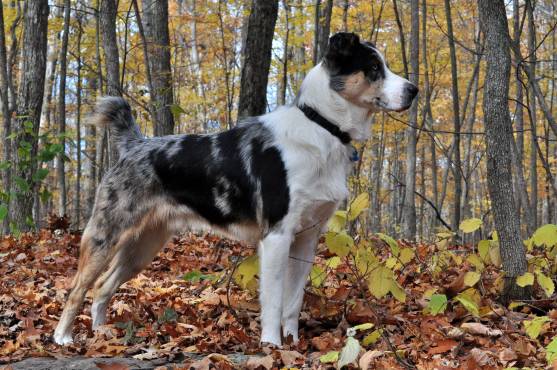Connect with a verified veterinarian in minutes. Licensed vets are available 24/7 to answer your questions. No need to worry about your furry family member.
Beagles are marvelous dogs! They have one of the best noses around and are great companions! This is a dog that truly loves to have fun and yet can do serious work when necessary. But did you know these dogs also come in an amazing array of color variations?
If you’re curious to learn a bit more about Beagles and their colors, then read on! We’ve put together information about the Beagle dog breed and their color variations!
What is a Beagle?
Beagles are classified as hounds, yet many people are familiar with these lovely dogs. The dogs are happy, outgoing, and affectionate dogs; these characteristics make them a favorite with many people.
The origin of the Beagle seems to go back to the Germans, but no one is completely sure. Archeologists have found beagle-like dogs mentioned in Greek writings dating from 400 BC. The Romans also seem to have had a beagle-type dog used for hunting rabbits. It’s thought these dogs were brought with the Romans when they conquered England. From there, the Romans may have bred their dogs with local hound dogs.
From ancient times, Beagles have been used as hunting dogs. These dogs have very sensitive noses. However, they are also used by farmers to help hunt down and eradicate rabbits and hares.
Eventually, Beagles made their way to the US, where they were first recognized by the AKC in 1884. Because of their keen sense of smell, Beagles are used as work dogs. They work to sniff out contraband at air ports, find criminals, and more. Airports turned to Beagles because they look more friendly and aren’t as intimidating as other dogs used for this work!
Beagle Appearance
Along with their famous noses, the breed standard for these dogs is “any hound color.” The most common color for Beagles is the tri-color, which has a black saddle across the back, white legs/chest/belly, and a white tip on the tail. The head and around the saddle are tan. However, there are color variations, which we’ll get to in just a little bit!
Beagles have a smooth, dense coat that’s resistant to rain. Beagles need to be brushed at least once a week, though more often is better. This works to keep the fur clean and shiny while removing dirt and shed fur.
Speaking of shedding, Beagles do shed. However, if you brush them more often, this removes the dead fur. It also helps keep the fur off furniture and clothing.

Review symptoms, medications & behavior to keep your pets healthy with a Vet Online in just minutes.
Ask a Vet Live NowDo Beagles Get Along with Other Pets?
That’s a great question! Beagles are very friendly dogs with everyone in their family. They love kids and playing. However, they should be well-supervised with young children. Never leave a child unattended with a Beagle or any other dog.
And Beagles do seem to get along well with other pets, including cats. Beagles love to be part of a pack, so having another dog or a cat can help the Beagle find the companionship he needs.
Beagle Colors
We were amazed to learn that the AKC recognizes 25 different Beagle color combinations and 6 different markings! However, some color combinations are rare and include the following colors (with various shades of each):
- Brown
- Blue
- White
- Black
- Lemon
- Tan
- Red
What are the AKC Recognized Color Combinations for Beagles?
Here, we’ll share each of the AKC recognized color combinations for Beagles!
1. Black & Tan
The black & tan Beagle is almost completely black. Black runs on their back, body, sides, most of the ears and tail, and across the face.
The tan markings are found on the edges of the ear, the tip of the tail and parts of the face. You’ll sometimes also find tan markings on the legs, rear end, and chest.
2. Black, Red, & White (Tri-Color) Beagle
Then there are Beagles that are black, red & white. They’re sometimes referred to as tri-colored Beagles. These dogs have a black “saddle” across their back, which may even reach their sides, neck, and tail.
The red on these dogs is not a bright red. Instead, it’s more similar to human red hair in color. The red may be found on the head, ears, and around the eyes. The color is also on their rear ends, thighs, and the underside of their tails.
White is found on the dogs’ paws, muzzles, and chests, as well as on the tips of their tails.
3. Black, Tan, and Bluetick Beagle
The black, tan, and bluetick Beagle is very different from other recognized color combinations in this breed. The “ticking” looks more like a pattern of freckles scattered over one area of the dog’s coat. Bluetick is a faded gray, with scattered dots and patches of almost black gray. In the light, this gray color looks almost blue.
The black, tan, and bluetick Beagle is another tri-colored Beagle. They may have black patches on their heads, ears, back, and near the base of their tails. Bluetick coloring usually surrounds the black and maybe found everywhere except on the Beagle’s muzzle and paws. These will be a copper or tannish color.
4. Black, Tan & White Beagles
The black, tan, and white Beagle is the most common color combination in this breed. Most of us recognize a Beagle with this type of coat!
The black coloring starts on the Beagle’s back and moves to the dog’s belly and halfway up the tail. Tan patches are found on the head, ears, and upper legs.
The white patches are found on the Beagle’s muzzle, paws, neck, chest, and the tip of the tail.
5. Black, White, & Tan Beagle
The black, white, & tan Beagle sports a larger are of black, with tan and white coloring. The tan may be found on the dog’s head, thighs, and parts of the belly.
The white coloring is usually on the dog’s chest, legs, and tail.
6. Blue, Tan & White Beagle
The blue, tan, and white Beagle is different than the Bluetick coloring mentioned earlier. You might call these blue tri-color Beagles. They have a distinctive blue, tan, and white coloring. Here, the blue almost looks more silver.
One interesting note is that the Beagles may lose their bluish coloring as they age. Some people then call them dark silver Beagles. What’s more, the dog’s nose may also be a bluish-black color, and the dogs have lighter-colored eyes.
7. Brown & White Beagle
Brown and white Beagles have white coats with patches of brown. The brown is usually found around the eyes, ears, upper back, and at the base of the tail. Some of the brown areas become pretty large.
There’s also a type of brown Beagle that is a dark brown color. Breeders sometimes refer to these dogs as “chocolate” Beagles. However, the AKC doesn’t recognize this as a separate official color.
8. Brown, White, Tan Beagle
Brown, white, and tan Beagles usually have a large brown patch that goes over their entire back. It can reach from the neck all the way to the hind legs and partway up the tail.
The tip of the tail and the dog’s legs, muzzle, and chest are also white.
9. Lemon White Beagle
Who would have thought a Beagle could be a lemon color? Well, the dog’s not a bright yellow, like a lemon, thankfully! Instead, he’s more of a golden color that’s very pretty. These dogs usually have white on their tails, muzzles, and paws.
What a beautiful and unusual coloration for a Beagle!
10. Red & White Beagle
The red & white Beagle is a bi-colored dog whose colors look similar to the lemon & white Beagle. However, the patches are red instead of a golden color.
The red color may vary from pale to deep chestnut.
11. Tan & White Beagle
Here’s another bi-colored Beagle—the tan & white Beagle. These dogs may have light beige patches on his ears and lower tail. He may also sport beige on his back and sides.
Occasionally, these dogs may even have enough black to be visible; however, they’re still tan & white Beagles.
The tan & white Beagle is the last color combination recognized by the AKC.
Non-Standard Beagle Colors
In this section, we’ll take a look at Beagle colors that are recognized by the AKC; however, they aren’t considered desirable Beagle colors. Some of these colors and combinations are very rare, and others are related to possible health issues.
12. Black
A solid black Beagle is truly rare! It is possible to have a completely black Beagle, however. They don’t sport any other color.
13. Black & White
The black and white Beagle is another curious color. The puppies may be born black & white and then change colors when they’re older! Their coloration may change as many as three times before it settles down!
14. Black, Fawn, & White
Fawn is a dilute red, which may also be called ivory, cream, or Isabella. A Black, fawn, & white Beagle is a tri-color dog.
15. Black, Tan, & Redtick
These dogs are similar to the Bluetick Beagles; however, they have red instead. The redtick coat may have darker spots of red against a pale background.
16. Blue Beagle
Just as there can be an all-black Beagle, there’s also a blue Beagle! The blue coloration is a dilute gene, which makes the black more a bluish color. While it’s possible to have solid black Beagles, a solid blue beagle is very rare.
17. Blue & White
The blue & white Beagle is a dilute black and white Beagle. Puppies with this coloration usually outgrow this color and change as they get older.
18. Brown
This is a solid brown Beagle, which is very rare. The brown may be a reddish-brown that’s very pretty.
19. Lemon
It’s also possible for a Beagle to be a solid lemon color, though this is also very rare!
20. Red Beagle
The red Beagle is a solid red, which comes in a variety of different shades. How pretty these dogs are!
21. Red & Black
The red & black bi-colored Beagle has a red base coast, with black markings or patches. They’re slightly more common than the solid-colored Beagles, but you still won’t see many of these around.
22. Red, Black & White
Here, again, the Beagle has a base coat of red, with some black and white patches over the body.
23. Tan
A tan Beagle has a solid tan or copper-colored coat. Really pretty dogs!
24. White Beagle
It’s even possible to have a solid white Beagle! These dogs are not true albinos yet still have a solid white coat.
25. White, Black & Tan
These Beagles have a white basecoat, with black & tan patches scattered over their bodies.
Are There Merle Colored Beagles?
Well, to start with, no. There are no merle Beagles. However, you may see breeders advertising a dog with a merle color, saying this is a rare coloring. The problem is these dogs don’t exist. It’s Blueticks that exist, but not a merle Beagle.
If you find a breeder who has merle Beagles, chances are the dogs are not purebreds. The dogs have probably been crossed with other dog breeds to achieve the merle pattern.
Then there are pocket Beagles. These dogs may be advertised as “toy” sized Beagles; however, there is no such thing. In this case, the breeder has most likely bred a Beagle with a smaller dog breed to produce the pocket Beagle. These dogs may also have rare colored coats.
Having said all that, it is possible to have a bluetick or redtick Beagle whose coat resembles a merle pattern. However, the freckles of these dogs should not be consumed with the merle pattern. Though, it can happen to inexperienced pet parents.
Summing It Up
Beagles come in a wide range of colors and patterns! Who knew? Each dog is a unique individual, with his own coloring and personality.
When you’re adopting a dog, does it really matter what color he is? Hopefully not! Any of these Beagles would make a great family companion!
Connect with a verified veterinarian in minutes. Licensed vets are available 24/7 to answer your questions. No need to worry about your furry family member.

Kim
Kim is a talented author, who loves animals especially dogs. She engaged in writing books and articles relating to animals a decade ago. Kim resides in Chicago with her husband and son. The family is the proud owner of a dog and a parrot (Jack and Lily). Kim wanted more than these two pets, but her husband put his foot down... She often visits elementary schools to talk to the kids about what she learned about pets and how they could learn from them.
Review symptoms, medications & behavior to keep your pets healthy with a Vet Online in just minutes.
Ask a Vet Live Now




